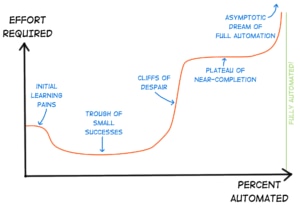Despite all the talk of all our jobs being replaced by automation, my experience is that the majority of enterprises are still very much employing engineers to design, build, and operate the infrastructure. Why, then, are most of us stuck in a position where despite experimenting with infrastructure automation, we have only managed to build tools to take over small, mission-specific tasks, and we've not achieved the promised nirvana of
Click Once To Deploy?
We Are Not Stupid
Before digging into some reasons we're in this situation, it's important to first address the elephant in the room, which is the idea that nobody is stupid enough to automate themselves out of a job. Uhh, sure we are. We're geeks, we're driven by an obsession with technology, and the vast majority of us suffer from a terrible case of
Computer Disease. I believe that the technical satisfaction of managing to successfully automate an entire process is a
far stronger short-term motivation than any fear of the potential long-term consequences of doing so. In the same way that hoarding information as a form of job security is a self-defeating action (as Greg Ferro correctly says, "if you can't be replaced, you can't be promoted"), avoiding automation because it takes a task away from the meatbags is an equally silly idea.
Time Is Money
Why do we want to automate? Well, automation is the path to money. Automation leads to time-saving; time-saving leads to agility; agility leads to money. Save time, you must! Every trivial task that can be accomplished by automation frees up time for more important things. Let's be honest, we all have a huge backlog of things we've been meaning to do, but don't have time to get to.
However, building automation takes time too. There can be many nuances to even simple tasks, and codifying those nuances and handling exceptions can be a significant effort, and large scale automation is exponentially more complex. Because of that, we start small, and try to automate small steps within the larger task because that's a manageable project. Soon enough, there will be a collection of small, automated tasks built up, each of which requires its own inputs and generates its own outputs, and--usually--none of which can talk to each other because each element was written independently. Even so,
this is not a bad approach, because if the tasks chosen for automation occur frequently, the time saved by the automation can outweigh the time spent
developing it.
This kind of automation still needs hand-holding and guidance from a human, so while the humans are now more productive, they haven't replaced themselves yet.
Resource Crunch
There's an oft-cited problem that infrastructure engineers don't understand programming and programmers don't understand infrastructure, and there's more than a grain of truth to this idea. Automating small tasks is something that many infrastructure engineers will be capable of, courtesy of some great module/package support in scripting languages like Python. Automating big tasks end-to-end is a different ball game, and typically requires a level of planning and structure in the code exceeding that which most infrastructure engineers have in their skills portfolio. That's to be expected: if coding was an engineer's primary skill, they'd more likely be a programmer, not an infrastructure engineer.
Ultimately, scaling an automation project will almost always require dedicated and skilled programmers, who are not usually found in the existing team, and that means spending money on those programming resources, potentially for an extended period of time. While the project is running, it's likely that there will be little to no return on the investment. This is a classic demonstration of the maxim that
you have to speculate to accumulate, but many companies are not in a position--or are simply unwilling--to invest that money up front.
The Cliffs Of Despair
With this in mind, in my opinion, one of the reasons companies get stuck with lots of small automation is that it's relatively easy to automate multiple, small tasks, but taking the next step and automating a full end-to-end process is a step too far for many companies. It's simply too great a conceptual and/or financial leap from where things are today. Automating every task is somewhere so far off in the distance, nobody can even forecast it.
They say a picture is worth a thousand words, which probably means I should have just posted this chart and said "Discuss," but nonetheless, as a huge fan of analyst firms, I thought that I could really drive my point home by creating a top quality chart representing the ups and downs of infrastructure automation.

As is clearly illustrated here, after the Initial Learning Pains, we fall into the Trough Of Small Successes, where there's enough knowledge now to create many, small automation tools. However, the Cliffs Of Despair loom ahead as it becomes necessary to integrate these tools together and orchestrate larger flows. Finally–and after much effort–a mechanism emerges by which the automation flows can be integrated, and the automation project enters the Plateau of Near Completion where the new mechanism is applied to the many smaller tools and good progress is made towards the end goal of full automation. However, just as the project manager announces that there are only a few remaining tasks before the project can be considered a wrap, development enters the Asymptotic Dream Of Full Automation, whereby no matter how close the team gets to achieving full automation, there's always just one more feature to include, one more edge case that hadn't arisen before, or one more device OS update which breaks the existing automation, thereby ensuring that the programming team has a job for life and will never achieve the sweet satisfaction of knowing that the job is finished.
Single Threaded Operation
There's one more problem to consider. Within the overall infrastructure, each resource area (e.g., compute, storage, network, security) is likely working their own way towards the Asymptotic Dream Of Full Automation and at some point will discover that full, end-to-end automation means orchestrating tasks between teams. And that's a whole new discussion, perhaps for a later post.
 As is clearly illustrated here, after the Initial Learning Pains, we fall into the Trough Of Small Successes, where there's enough knowledge now to create many, small automation tools. However, the Cliffs Of Despair loom ahead as it becomes necessary to integrate these tools together and orchestrate larger flows. Finally–and after much effort–a mechanism emerges by which the automation flows can be integrated, and the automation project enters the Plateau of Near Completion where the new mechanism is applied to the many smaller tools and good progress is made towards the end goal of full automation. However, just as the project manager announces that there are only a few remaining tasks before the project can be considered a wrap, development enters the Asymptotic Dream Of Full Automation, whereby no matter how close the team gets to achieving full automation, there's always just one more feature to include, one more edge case that hadn't arisen before, or one more device OS update which breaks the existing automation, thereby ensuring that the programming team has a job for life and will never achieve the sweet satisfaction of knowing that the job is finished.
As is clearly illustrated here, after the Initial Learning Pains, we fall into the Trough Of Small Successes, where there's enough knowledge now to create many, small automation tools. However, the Cliffs Of Despair loom ahead as it becomes necessary to integrate these tools together and orchestrate larger flows. Finally–and after much effort–a mechanism emerges by which the automation flows can be integrated, and the automation project enters the Plateau of Near Completion where the new mechanism is applied to the many smaller tools and good progress is made towards the end goal of full automation. However, just as the project manager announces that there are only a few remaining tasks before the project can be considered a wrap, development enters the Asymptotic Dream Of Full Automation, whereby no matter how close the team gets to achieving full automation, there's always just one more feature to include, one more edge case that hadn't arisen before, or one more device OS update which breaks the existing automation, thereby ensuring that the programming team has a job for life and will never achieve the sweet satisfaction of knowing that the job is finished.







